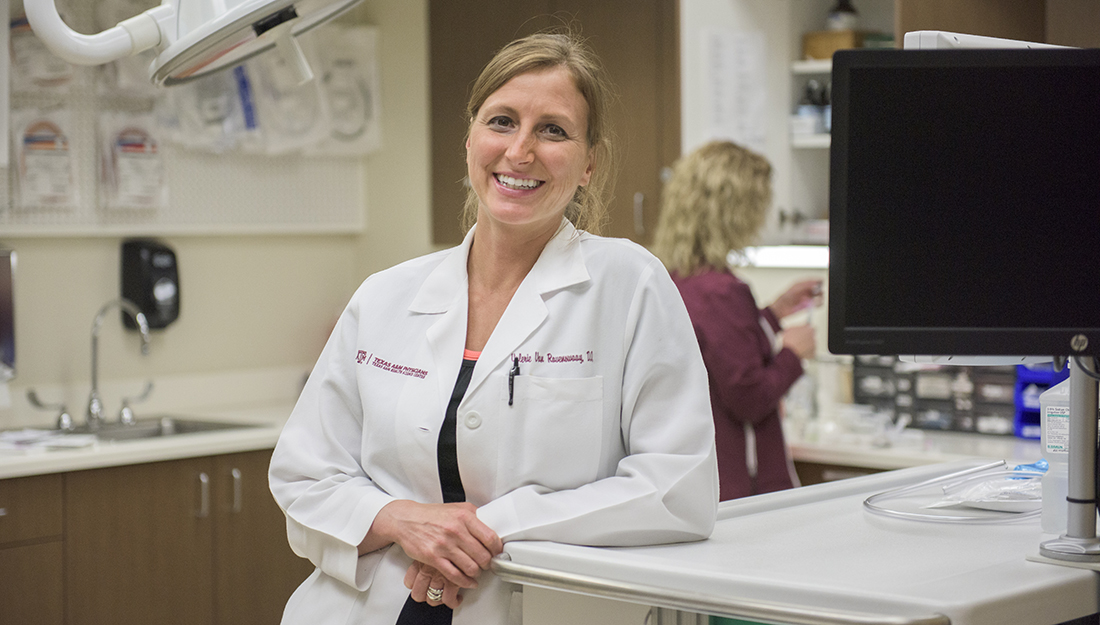On a mission, right here at home

Texas A&M College of Medicine was created to serve the people of central Texas, particularly medically underserved populations. As an extension of Texas A&M, the Texas A&M Physicians Family Medicine Clinic (TAMP) is delivering on that promise in Aggieland.
With a main practice clinic in Bryan, Texas, and a satellite clinic in Navasota, Texas, TAMP combines the missions of healing, prevention and medical education. TAMP is the only one of its kind in the twin cities, and it’s making an impact on the residents of 17 counties in central Texas—which are mostly rural, medically underserved or both.
Why is it unique? TAMP serves the local community by providing services that positively influence some of the most costly preventable diseases in the area through primary care services, obstetric and gynecological care, cancer screening and sports medicine—and it’s also home to the Texas A&M Family Medicine Residency, the only residency in Bryan-College Station.
In addition to being a stand-alone clinic, TAMP seeks to serve a population that may otherwise not receive health care, and staff members are trained to make sure that those who can’t afford it and those who can’t find transportation are still able to access services.
Access to care is especially important in family medicine, which treats many of the preventive and chronic diseases that are some of the most prevalent and costly burdens on modern day health care, significantly affecting the quality of life for Texans. Chronic disease accounts for 75 percent of Texas health care expenditures.
The clinic is just six years old, but it has already made strides in helping the community. TAMP was recently awarded national recognition for patient-centered care and designated as a National Committee for Quality Assurance (NCQA) Patient-Centered Medical Home (PCMH). The award recognizes clinics for using evidence-based, patient-centered processes that focus on highly coordinated care and a greater-than-usual commitment to continuity for patients and physicians.
The 20 faculty and 27 resident physicians who make up the practice provide women’s care, physical exams, stress tests, steroid injections for pain relief, colonoscopies, dermatological surgeries, esophagogastroduodenoscopy, spirometry, vasectomies and Essure sterilizations.
TAMP is able to quickly make diagnostic decisions and increase the speed of treating patients with point of care testing, an endoscopy suite, in-clinic X-rays with a full-time technician and vascular, obstetrical and orthopedic ultrasounds.
Morgan Hines, MD, a resident with TAMP, says the variety is certainly beneficial for her training.
“You never really know what you’re going to see on any given day,” Hines said. “We might be performing endoscopies in the morning, delivering a baby over lunch and admitting a patient to the ICU in the afternoon. I believe this residency is about pushing limits.”
In addition to a commitment to full-scope family medicine, the residency and TAMP specialize in the care of underserved and rural populations—part of the Texas A&M University Health Science Center and Texas A&M College of Medicine’s priorities.
“We are a community-based program,” said Rae Adams, MD, director of the Texas A&M Family Medicine Residency. “We are training our residents to become community leaders while honing the skills to do high-risk and surgical obstetrics, endoscopy and both inpatient care and outpatient procedures.”
TAMP and its residents provide care to a local prenatal clinic, which cares for the mothers of more than 25 percent of the children born in Brazos County. This not only increases the impact that the clinic has on patients, it also gives residents prenatal experiences they wouldn’t see through other clinical experiences.
As the home to the Texas Cancer Screening, Training, Education and Prevention Program (C-STEP), TAMP provides critical safety-net services, such as cancer screenings and certain advanced diagnostics, to uninsured, underserved and low-income Texans. Texas C-STEP is funded by grants from the Cancer Prevention & Research Institute of Texas. The grants provide much needed access to women’s health services and colonoscopy, while also enhancing screening capacity and physician training. The program serves as a state and nationwide model for translating cancer screening services, such as colonoscopy, into the family practice setting.
In its first three years, the grant has provided for 373 clinical breast exams, 993 mammograms, 203 breast ultrasounds, 43 breast biopsies, 474 Pap tests, 215 colposcopies (a way of diagnosing cervical issues) and 49 loop electrosurgical excisions, or LEEPs, another way of diagnosing and curing problems of the cervix. The program has also likely reached 161,000 people through television, radio, brochures and other outreach and 5,177 people have been educated one-on-one by community health workers. There have been 11 breast cancers and 2 cervical cancers found and 141 cervical cancer precursors diagnosed.
Uninsured or underinsured women living in any of the 17 counties who qualify based on their income level, which can be up to 250 percent of the Medicaid federal poverty guidelines are eligible to participate. They are women between 21 through 64 years of age and are the group least likely to be covered by Medicare or Medicaid. They are also among the ages that need the tests the most: Screening mammograms are recommended every two years for women 50 to 74 years of age, and Pap tests are recommended every three years for women aged 21 through 64.
Now, TAMP is able to meet women in their area towns through “mobile mammogram days” funded under the grant. These units can travel to rural counties and provide screenings in accessible locations like churches and community centers for patients that otherwise wouldn’t be able to be screened.
Simply put, TAMP is the clinical extension of the Texas A&M College of Medicine’s historical roots. The college, which celebrated its 40th anniversary in 2017, was created by a federal act that created new medical schools across the country. The purpose of these medical schools was to care for underserved populations. As the home to numerous outreach programs, clinical care and residency training, TAMP is helping Texas A&M deliver on this mission.
Media contact: media@tamu.edu


